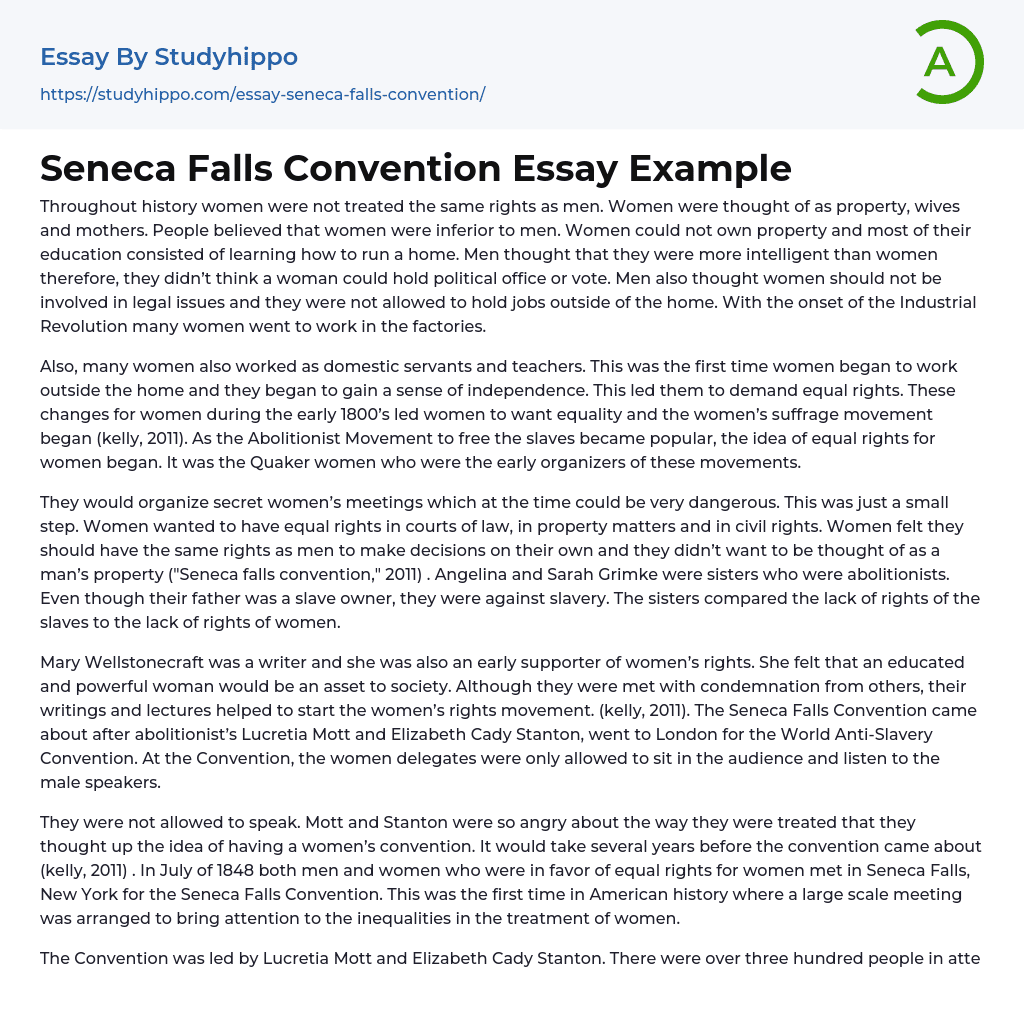Throughout history, women have experienced discrimination and were regarded as property, mostly being wives and mothers. They were deemed inferior to men by society, which led to limited rights and opportunities. Women had no ownership of property and their education revolved around domestic duties. This resulted in their exclusion from political involvement and voting due to perceived intellectual incapability. Moreover, they were denied access to legal matters and non-domestic job prospects. Nevertheless, a notable amount of women started working in factories during the Industrial Revolution.
In the early 1800s, women began exploring various professions beyond their traditional roles at home, such as domestic servants and teachers. This shift in occupation granted them newfound independence and sparked a longing for equal rights. Consequently, this desire for equality gave rise to the women's suffrage movement. Simultaneousl
...y, there was an increasing backing for the Abolitionist Movement, which aimed to emancipate slaves. Notably, Quaker women played pivotal roles in organizing both these movements (Kelly, 2011).
Organizing secret women’s meetings was a perilous endeavor during that time, but it was a small step towards achieving equal rights. Women desired equal treatment in courts, property matters, and civil rights. They advocated for the right to make decisions independently, refusing to be seen as mere property of men ("Seneca falls convention," 2011). Angelina and Sarah Grimke, sisters and abolitionists, stood against slavery despite their father's ownership of slaves. They drew parallels between the oppressed rights of slaves and women.
Mary Wellstonecraft was a writer who actively supported women's rights. She believed that an educated and empowered woman would benefit society. Despite facing criticism, her writings and lecture
played a significant role in initiating the women's rights movement (Kelly, 2011). Following their participation in the World Anti-Slavery Convention in London, abolitionists Lucretia Mott and Elizabeth Cady Stanton organized the Seneca Falls Convention. At this convention, female delegates were relegated to the audience and had no speaking roles while the male speakers took the stage.
Mott and Stanton came up with the idea of organizing a women's convention after facing silence and mistreatment. It took several years for the convention to actually happen (Kelly, 2011). In July of 1848, advocates for women's equal rights, including both men and women, gathered in Seneca Falls, New York for the Seneca Falls Convention. This was a significant event as it was the first large-scale gathering in American history that aimed to draw attention to the unequal treatment of women.
Led by Lucretia Mott and Elizabeth Cady Stanton, the Convention had over three hundred participants. Elizabeth Cady Stanton authored the Declaration of Sentiments and Resolutions, drawing inspiration from the Declaration of Independence. At the Convention, she presented it, emphasizing gender equality for women and denouncing any oppression by men. The primary demand expressed in the Declaration was for women's suffrage since they believed that without this right, women would lack equal freedom to men. Throughout the Convention, debates led to discussions and enhancements being made to the Declaration.
The majority of the resolutions at the Convention had unanimous support and were signed by sixty-eight women and thirty-two men, including Frederick Douglas, a former slave (kelly, 2011). Despite facing anger from religious leaders and the press, the Seneca Falls Convention was a significant moment in women's
fight against unfair treatment and their demand for equal rights. It provided them with a platform to express themselves and strive for equality. However, it took seventy-two more years before women finally achieved this right.
The Nineteenth Amendment, which was ratified in 1920 (kelly, 2011), emerged directly from the significant role played by the Seneca Falls Convention in promoting democracy. Despite the belief in "all men are created equal," women experienced unequal treatment and began to question this notion. In order for the United States to be recognized as a true democratic society, it was essential to ensure equal treatment for all its citizens. Therefore, both the abolitionist movement and the Seneca Falls Convention were pivotal moments in our nation's history as they fully embraced its fundamental principles.
- Malala essays
- Activism essays
- Communism essays
- Conservatism essays
- Liberalism essays
- Marxism essays
- Nationalism essays
- Patriotism essays
- Policy essays
- Public Policy essays
- Social Contract essays
- Socialism essays
- Totalitarianism essays
- Addiction essays
- Anatomy and Physiology essays
- Biodegradation essays
- Cancer essays
- Dental Care essays
- Disability essays
- Disease essays
- Disorders essays
- Health Care essays
- Infectious Disease essays
- Inquiry essays
- Intelligence Quotient essays
- Lung Cancer essays
- Medicine essays
- Neurology essays
- Nutrition essays
- Olfaction essays
- Physical Exercise essays
- Public Health essays
- Sex essays
- Women's Health essays
- World health organization essays
- Women Empowerment essays
- Women'S Rights essays
- Women's Suffrage essays




